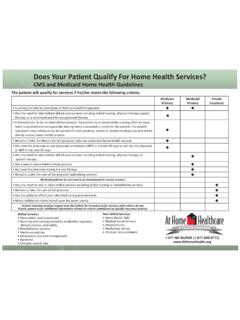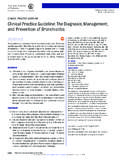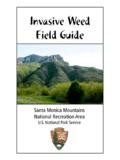Transcription of Learning At Home: Nursing Management of …
1 Learning At Home: Nursing Management of respiratory syncytial bronchiolitis 1 Nursing Management of respiratory syncytial bronchiolitis Objectives The goal of this program is to inform the nurse about respiratory syncytial brochiolitis in the pediatric population. After completion of this course, the nurse will be able to: Discuss the prevalence, incidence, and pathophysiology of RSV. Contrast the clinical presentation of infants and young children with RSV with that of older patients with RSV. List the risk factors for RSV. Discuss Nursing care for the child with RSV. Identify infection control practices to prevent the spread of infection in the home health setting. Case Study: Corina is a private duty nurse for an 11 month-old boy named Nathan. He has a medical history significant for cerebral palsy, seizures, prematurity, developmental delay, and gastrostomy.
2 The patient receives Nursing services Monday-Friday while his mother works as an elementary school teacher. On Monday, the mother reported that Nathan had a stuffy nose and slight cough over the weekend. During the assessment, the nurse observes the patient to have a productive cough and slightly increased respiratory rate. The patient often demonstrates adventitious lung sounds due to an inability to control secretions. The nurse continues to observe the infant throughout the shift. During the afternoon hours, the nurse observes the patient to have a worsening productive cough, respiratory rate of 54 breaths/min, chest retractions, and nasal flaring. Ausculatation reveals generalized expiratory wheezing and fine crackles through the lung fields. She also notes that the patient s nutritional intake is reduced and he is lethargic.
3 She notifies the mother and physician. The patient is taken to the ER for evaluation, diagnosed with RSV, and is admitted for further observation. What should the nurse have done differently? How could the nurse differentiate between the patient s normal lung sounds and a change in condition? Learning At Home: Nursing Management of respiratory syncytial bronchiolitis 2 respiratory syncytial virus , more commonly referred to as RSV, is a leading cause of bronchiolitis in children under the age of two. It is estimated that more than 80% of infants are exposed to this condition by their first birthday, but only a small percentage of children experience severe disease. For most children, RSV is self-limiting and can be treated on an outpatient basis. Bronchiolitits is a respiratory syndrome characterized by inflammation and mucus production in the bronchioles of the lung (Centers for Disease Control [CDC], 2010).
4 It often begins in the upper respiratory tract but can invade lower airway structures. If not treated appropriately, complications such as pneumonia and respiratory failure may occur. Children with underlying cardiac, pulmonary, or immune system deficiencies are at an increased risk of developing life-threatening complications. Prevalence and Incidence of respiratory syncytial virus bronchiolitis As with many of the childhood respiratory infections prevalent in the United States, RSV outbreaks occur during the fall and winter months beginning in November. RSV peaks in late January and begins to subside by early spring. The average outbreak cycle is approximately 16 weeks (American Academy of Pediatrics [AAP], 2006). RSV can occur in all age groups but is most prevalent in the infantile population. When RSV occurs in the older child, or adult population, symptoms and disease progression are often mild and may be comparing to symptoms of a common cold.
5 Infection rates peak in infants between the ages of 6 weeks to 12 months. Approximately 30% of children with RSV develop pneumonia. Research reports that up to 125,000 children in the United States under the age of one year require hospitalization for RSV and related complications with an average cost of more than $40, per hospitalization (CDC, 2010). Globally, RSV is the most common cause of childhood acute lower respiratory infection and remains a major cause of acute care admissions. In 2005, there were million cases world wide with million hospital admissions (Nair et al., 2010). Mortality rates for RSV are estimated at 5%. Risk Factors of RSV Certain factors have been reported to increase the risk of severe infection from RSV. Premature infants are among the population with the highest risk of complications. Because they are born before they have acquired protective maternal antibodies, they are not able to fight off infection as well as a full term infant.
6 Additional risk factors include (a) birth within 6 months of RSV season, (b) school-aged siblings, (c) day care attendance, and (d) crowded living conditions (AAP, 2006). Risk factors for severe disease have been reported in the literature as: (a) infants less than 6 weeks of age, (b) premature infants Learning At Home: Nursing Management of respiratory syncytial bronchiolitis 3 with a gestational age less than 36 weeks, (c) complicated chronic heart disease, (d) chronic lung disease of prematurity, (e) cystic fibrosis, (f) immunosuppressive disease and/or therapy, and (g) multiple congenital anomalies (Nair et al., 2010). Spread of RSV Infection RSV is traditionally an airborne disease but it can be spread through direct contact with nasal or oral secretions from an infected individual. Airborne diseases are spread when droplets of pathogens are expelled into the air due to coughing, sneezing or talking (CDC, 2010).
7 Transmission can be direct or indirect. Direct contact occurs when an individual touches infected host material. Indirect transmission occurs when the virus is transmitted to an environmental surface and then contacted by another individual. RSV found in acute infection can survive on hard surfaces for approximately 6 hours and on soft surfaces for up to 30 minutes (CDC, 2010). RSV has an incubation period of approximately 4 days; however, the virus can be shed in nasal secretions for up to three weeks following infection (CDC, 2010). In the home setting, clinicians can transmit disease from one home to another through the use of medical supplies, clothes, and/or therapy supplies. In known cases, contact isolation is necessary. In addition to standard precautions, clinicians should use personal protective equipment including gowns and gloves for known or suspected cases.
8 Masks and/or goggles should be considered for close contact with infected individuals (AAP, 2006). For rehabilitative therapists, care should be held for patients with known or suspected infection. Visits can be resumed once the patient is well. The use of strict hand washing and environmental disinfection is needed to reduce the spread of infection. Pathophysiology of RSV RSV is a virus that replicates in the epithelial cells that line the respiratory tract. It can affect any portion of the respiratory tract; however, it may spread from the upper respiratory tract into the lower tract by microbe invasion and aspiration of nasopharyngeal secretions. The epithelium in the bronchi and bronchioles become inflamed, edematous, and necrotic. This leads to tissue necrosis and sloughing of necrotic material. In addition, mucous production is increased which results in airway obstruction and impaired air movement and gas exchange (AAP, 2006).
9 Presenting Characteristics Young children with RSV often present with rhinorrhea, nasal congestion, low-grade fever, irritability, restlessness, cough, and feeding difficulties. If the virus is restricted to the upper respiratory tract, the infant may demonstrate symptoms of a common cold, lasting four to six days. As the condition worsens, breathing becomes impaired. Infants may present with nasal flaring, retractions, grunting, and tachypnea. Additional symptoms including respiratory muscle fatigue, cyanosis, hypoxemia, and apnea may occur in severe Learning At Home: Nursing Management of respiratory syncytial bronchiolitis 4 cases of RSV infection. Treatment of severe RSV infections may require intensive care and mechanical ventilation. In older children and adults, symptoms may include nasal congestion, cough, rhinorrhea, and low-grade fever.
10 Diagnosis of RSV Diagnosis is made based upon a review of the clinical presentation of the child and the recent history. Clinical Practice Guidelines developed by the American Academy of Pediatrics and published in 2006, suggests that clinicians should not routinely order laboratory and radiographic studies for the purposes of diagnosis. However, in cases that need a viral confirmation, a definitive diagnosis of RSV can be made by virus isolation, detection of viral antigens or viral RNA, or a demonstration of a rise in associated serum antibodies (AAP, 2006). The best specimens for RSV recovery are nasal secretions obtained by suction or nasal swabbing. Antigen detection assays such as the Direct Immunofluorescent Assay Antigen test can provide rapid results in 15 minutes. Benefits to rapid viral identification include (a) prompt initiation of antiviral medications to reduce symptoms and complications, (b) less use of unnecessary antibiotics, (c) reduction in diagnostic testing, and (e) more rapid initiation of infection control measures.







